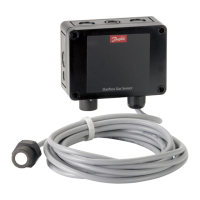1. Intended use This document has the intent to provide the guidelines to avoid possible damages deriving from
overvoltage and other possible issues resulting from the connection to the DGS power supply and
the serial communication network. Moreover it provides the operations executed via handheld
Service Tool. The display of the hand-held Service Tool and the MODBUS interface for integration with
Building Management Systems is used as interface for operation, commissioning and calibration of
the DGS gas detection unit.
2. Introduction
For what concerns display devices, this user guide contains the maximum possible functionality.
Depending on the DGS type some features described here are not applicable and therefore the menu
items may be hidden.
Some special features are available via the hand-held Service Tool interface only (not via MODBUS).
This includes the calibration routine and certain properties of the sensor head.
3. Installation and
maintenance
This unit must be installed by a suitably qualified
technician who will install this unit in accordance
with these instructions and the standards set
down in their particular industry/country.
Suitably qualified operators of the unit should be
aware of the regulations and standards set down
by their industry/country for the operation of this
unit.
These notes are only intended as a guide, and
the manufacturer bears no responsibility for the
installation or operation of this unit.
Failure to install and operate the unit in
accordance with these instructions and with
industry guidelines may cause serious injury
including death, and the manufacturer will not
be held responsible in this regard.
It is the installer’s responsibility to adequately
ensure that the equipment is installed correctly
and set up according to the environment and the
application in which the products are being used.
3.2 Regular Test
3.1 Technician use only!
Please observe that DGS works as a safety
device securing a reaction to a detected high
gas concentration. If a leakage occurs, the
DGS will provide alarm functions, but it will
not solve or take care of the leakage root
cause itself.
3.3 Location
For all gases heavier than air, Danfoss
recommends placing the sensor head app. 30 cm
(12”) above the floor and, if possible, in the air
flow. All gases measured with these DGS sensors
are heavier than air: HFC grp 1, HFC grp 2, HFC
grp 3, CO and propane.
For further details on Test and Location please see
the Danfoss Application Guide: “Gas detection in
refrigeration systems”.
To maintain product performance and comply
with the local requirements, the DGS must be
tested regularly.
DGSs are provided with a test button that may be
activated to validate the alarm reactions.
Additionally, the sensors must be tested by either
bump test or calibration.
Danfoss recommends the following minimum
calibration intervals:
DGS-IR: 60 months
DGS-SC: 12 months
DGS-PE: 6 months
With DGS-IR it is recommended to do an annual
bump test in years without calibration.
Check local regulations on calibration or testing
requirements.
For propane: after exposure to a substantial gas
leak, the sensor should be checked by bump test
or calibration and replaced if necessary.
User Guide | Danfoss Gas sensor, type DGS
© Danfoss | Climate Solutions | 2022.01 BC291049702513en-000201 | 3

